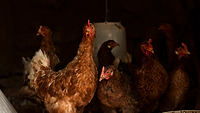High Levels of Resistance to Critical Drugs Among Pathogens in Kenyan Meat Point to Global Trend of Increasing AMR

Credit: Berend de Kort via Pexels
A recent study, published in the peer-reviewed journal Antibiotics, has added to the growing amount of evidence regarding the global rise of antimicrobial resistance (AMR) in foodborne pathogens, finding concerning levels of microbiological contamination and multidrug resistance (MDR) to critical antibiotics among pathogens isolated from pork and poultry meat samples purchased from leading retail outlets in Kenya.
According to the World Health Organization (WHO), AMR is a leading cause of death around the world, and was associated with 4.95 million deaths in 2019 alone. The spread of resistant genes and pathogens has been accelerated by a number of environmental and social factors, such as the inappropriate use of antibiotics in agriculture. The international community has turned its attention to mitigating the increasing trend of AMR, of which AMR in foodborne pathogens is a large part, in recent years.
In light of the increasing trend of AMR in Kenya and Kenya’s heavy use of antimicrobials in animal agriculture, the present study was conducted to determine the presence of foodborne bacteria in pork and chicken products and the resistance profiles of the isolates to selected clinically relevant antibiotics. The study states that, in 2013, an estimated 395 tons of antibiotics were used for food animal production in Kenya, of which 43 percent of are classified as “critically relevant” by WHO.
Additionally, the study points to research that supports the hypothesis linking antimicrobial use in agricultural production systems and the emergence of AMR, especially the pronounced lack of biosecurity measures and low animal welfare practices. For example, since Sweden banned the use of antimicrobials as growth promoters in animal agriculture in 1986, the country reduced the amount of antibiotics administered to livestock by 65 percent, and as a result, has seen a substantial reduction in the emergence and spread of AMR nationwide.
In the present study, researchers obtained 393 pork and poultry samples from an international retail chain and a regional retail outlet. Nearly 98.4 percent of pork and 96.6 percent of poultry samples tested positive for at least one type of bacterium. In total, 611 bacterial isolates were recovered from the analysis of the 393 pork and poultry samples, but only 551 isolates were processed further due to resource availability.
Escherichia coli was the most common Gram-negative bacteria in both pork and poultry samples, at 47.7 percent and 49.2 percent, respectively. Meanwhile, Staphylococcus was found in 9.3 percent of pork samples and 4.2 percent of poultry samples. However, it was difficult to identify Staphylococcus aureus, which is known to cause staphylococcal food poisoning, as the classical biochemical methods used were limited. Additional isolates included Klebsiella (19.1 percent), Salmonella (17.8 percent), Shigella (7.5 percent), and Pseudomonas (0.3 percent).
Among the total bacterial isolates, 38.5 percent were MDR. Resistance was noted for “critically essential” antimicrobials such as rifampicin (96 percent), ampicillin (35 percent), cefotaxime (9 percent), cefepime (6 percent), and ciprofloxacin (6 percent). Moreover, there study revealed high resistance to key antimicrobials for veterinary medicine such as tetracycline (39 percent), sulfamethoxazole (33 percent), and trimethoprim (30 percent). Furthermore, the study states that an analysis of similar data showed that resistance to essential antibiotics—such as cephalosporins, aminoglycosides, and fluoroquinolones—are rising.
Analysis of the present data also showed worrying levels of resistance to tetracycline and penicillin, two of the most commonly used antibiotics in animal agriculture, demonstrating the necessity of responsible antibiotic use, improved and humane animal production methods, and increased biosecurity levels. Also concerning is the fact that some isolates were resistant to more than three types of antibiotics, which could make it more difficult to treat foodborne illnesses and other diseases.
The researchers emphasize that it is essential to spread awareness about the judicious use of antibiotics and take preventive measures to foodborne reduce disease burden associated with AMR bacteria. The researchers also stress the importance of enforcing high standards of food hygiene and sanitation throughout the supply chain, especially at the time of slaughter and packaging, as well as at the retail level. The high level of microbial contamination of chicken and meat products from both local and international supermarkets suggests significant food safety concerns.Looking for a reprint of this article?
From high-res PDFs to custom plaques, order your copy today!






